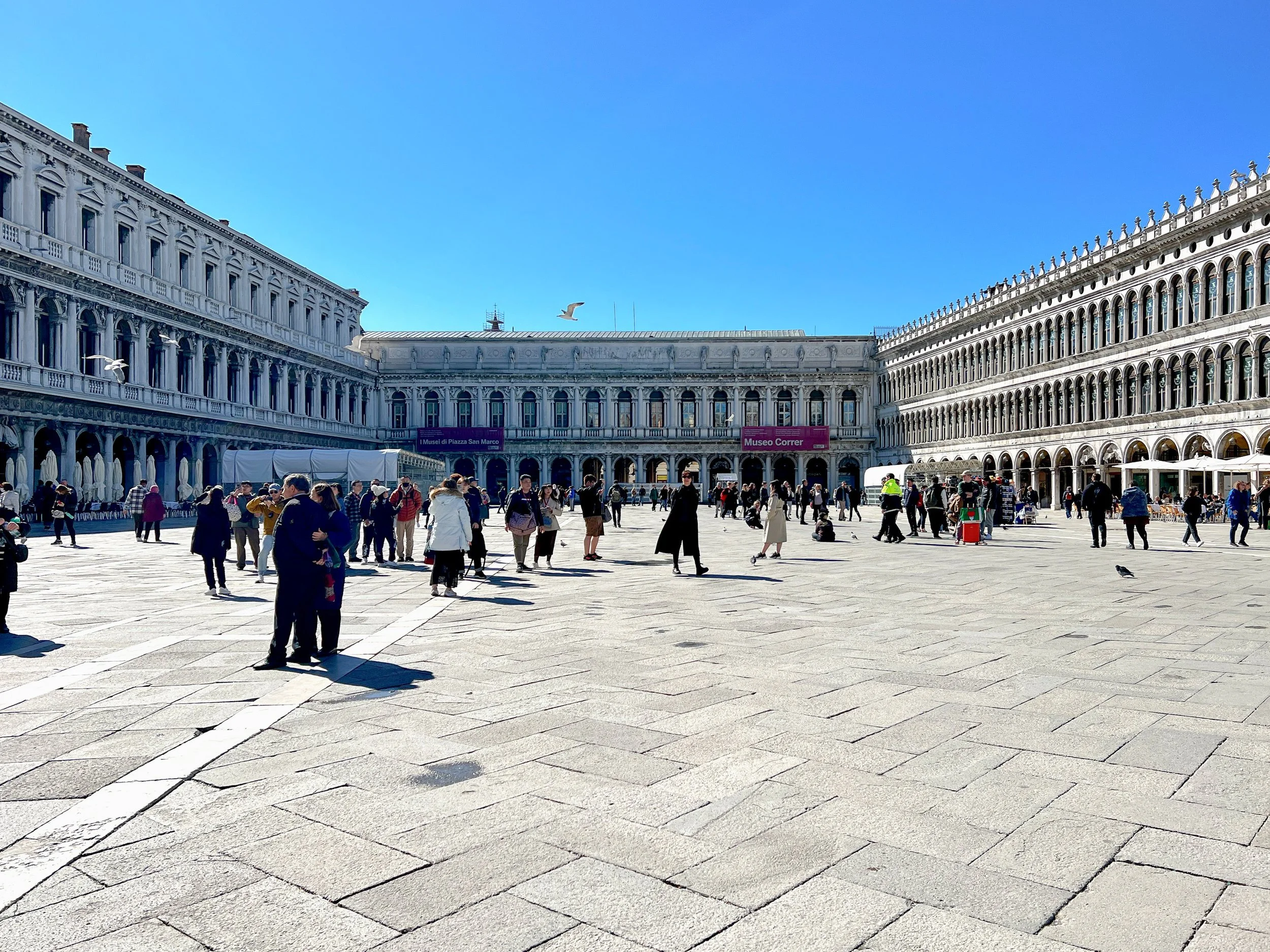San Geminiano in Piazza San Marco, demolished by Napoleon
Canaletto. Piazza San Marco, Looking toward San Geminiano. c 1735. Source: Wikimedia Commons
Here’s the Piazza San Marco, painted by Canaletto around 1735. In many respects, lookin in many ways very similar to the way it does today. However, on closer inspection, the western end of the Piazza, seen in the background, is very different. For a start, there’s a church which no longer exists. Have a look at the picture below taken in March 2023.
Piaza San Marco, 15 March 2023.
The missing church is San Geminiano. Started in 1505 to designs by Cristoforo da Legname it was completed by Jacopo Sansovino in 1557. Sansovino, whose other buildings around the Piazza include the Libreria (Biblioteca Marciana) and the Zecca (the Mint), designed the facade and added a dome.
Detail from Canaletto. Piazza San Marco, Looking toward San Geminiano. c 1735. Source: The Churches of Venice
What happened to San Geminiano?
After Napoleon conquered Venice, he decided that he needed a new royal palace, for which he appropriated various buildings around the Piazza. One of the things he wanted was a large room for public ceremonies, with a monumental staircase, which opened on to the Piazza. And so the Ala Napoleonica was created, and San Geminiano was demolished. Collateral damage, as it were. Below are a pair of before and after pictures.
View of the former church San Geminiano (or San Giminiano) at the west side of the Piazza San Marco (St Mark’s Square) which was destroyed in 1807 in order to build the Ala Napoleonica. Plate VIII, entitled Lato di San Giminiano qual’ era nel passato Secolo, from La Piazza di San Marco in Venezia, descritta da Antonio Quadri e rappresentata in XVI. tavole rilevate ed incise da Dionisio Moretti Source: Wikimedia Commons
View of the Ala Napoleonica (1810) at the west side of the Piazza San Marco. Plate VII, entitled Nuova Fabbrica del Palazzo Reale, from La Piazza di San Marco in Venezia, descritta da Antonio Quadri e rappresentata in XVI. tavole rilevate ed incise da Dionisio Moretti Source: Wikimedia Commons
San Geminiano had added variety and visual interest to the square, the renaissance church being a counterpoint to the Basilica of San Marco at the opposite end of the piazza. The Ala Napoleonica, while not unattractive in itself, makes the Piazza less visually lively than it used to be. Things are somewhat more uniform, but that’s not the point, because the whole ensemble is not a symmetrical composition: the buildings on either side of the Ala Napoleonica (the Procuratie Vecchie on the north side and the Procuratie Nuove on the south side) complement each other but are different in scale and detail, as can be seen from my photograph, and in the comparative historical elevations below:
Historical elevations by David Chipperfield Architects. Source ArchDaily
“The Ala Napoleonica completed Piazza San Marco bringing it coherence and unity”, according to the Fondation Napoléon, but they would say that, wouldn’t they.
Others might consider this an egregious act of vandalism inflicted on one of the world’s finest urban spaces.
A few more views of the Piazza with San Genminiano:
The Piazza San Marco towards San Geminiano, attributed to Giacomo Guardi (1764–1835), Source: The Met, New York
(Giacomo Guardi was the son of Francesco Guardi, and little is known of him, but he would have been working before and after the Napoleonic conquest, and it’s not clear if this picture was painted before or after the demolition of San Geminiano.)
Piazza San Marco. c1740. Attributed to Bernardo Bellotto. Source The Cleveland Museum of Art.
Belotto, incidentally, was Canaletto’s nephew, and sometimes called himself “Canaletto” as well, which can cause some confusion to those not attuned to the nuances of the two artists.
Piazza San Marco (detail showing the church of San Geminiano). c1740. Attributed to Bernardo Bellotto. Source The Cleveland Museum of Art
View by Francesco Guardi of the Piazza San Marco, 1776, showing the church of San Geminiano.
Note the temporary wooden pavilions constructed for the Festa of the Sensa (Ascension). Source Wikipedia
On the pavement in front of the entrance to the Correr Museum, where the church once stood, is this commemorative slab .
Jacopo Sansovino
here built in 1557
the new church
of San Geminiano
demolished in 1807
Source: byronico.com











